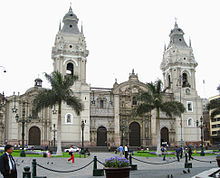Lima Metropolitan Cathedral
| Cathedral of Lima | |
|---|---|
 Cathedral of Lima | |
| Religion | |
| Affiliation | Roman Catholic |
| Ecclesiastical or organizational status | Basilica |
| Location | |
| Location | Lima District, Lima, Peru |
| Geographic coordinates | 12°02′47.30″S 77°01′48.13″W / 12.0464722°S 77.0300361°W |
| Architecture | |
| Completed | 1538 |
The Basilica Cathedral of Lima is a Roman Catholic cathedral located in the Plaza Mayor of downtown Lima, Peru. Construction began in 1535, and the building has undergone many reconstructions and transformation since, however it still retains its colonial structure and facade.
Description



In keeping with the majority of cathedrals the front facade has three large doorways. The main or central gateway is called the Portada del Perdón or the "door of forgiveness". Above the doorway, instead of Lima's coat-of-arms, there appears the Peruvian seal, and the phrase "Plus Ultra".
There are also no less than 14 side doors; one of which opens on to Calle de Judíos (Street of the Jews) and another on to the Patio de los Naranjos (Square of the Oranges, connected to the Cathedral). At the rear there are 2 more entrances: Santa Apolonia and San Cristóbal. Set on the front facade are sculptures of the Apostles and in the middle, the Sacred Heart of Jesus. Adjoining the Cathedral are the Parroquia del Sagrario (one of the oldest ones in Lima) and the Archbishop's Palace.
Inside, along the side aisles, are a sequence of large paintings of the Via Crucis, "Way of the Cross. Pope John Paul II has visited this cathedral on two occasions, in 1985 and 1988. This is commemorated with signs at the entrance. In the left aisle, the first chapel holds the ancient baptistery. Here can be seen a beautiful image of Nuestra Señora de la Esperanza, who presides over the events during Cuaresm and Holy Week. During a recent restoration, ancient pictures were found in this chapel that are now able to be seen by the public.
The next chapel is Capilla de la Sagrada Familia (chapel of the Holy Family), featuring figures of Jesus, Mary and Joseph.
The Cathedral also contains the tomb of the Spanish conquistador of Peru, Francisco Pizarro.
Timeline
The following chronological data is based on the work of the priest Antonio San Cristóbal.[1]
- January 18, 1535:
The conqueror Francisco Pizarro laid the first stone, carrying on his shoulders the first log used in the construction of the Cathedral. The chosen location was between the Main Plaza and the "Street of the Jews," ("Calle de Judíos", in Spanish).
- 1538: The construction of the first church was completed. It was mainly built of adobe, primitive, small and rustic.
- March 11, 1540: The church was officially inaugurated by Francisco Pizarro.
- May 14, 1541: A papal bull of Pope Paul III, Illius Fulciti Praesidio, designated the church a Cathedral, by creating the diocese of the City of the Kings. The Cathedral now became part of the assigned region of Saint John the Evangelist ("San Juan Evangelista" in Spanish) and ceased to depend on Cusco.
- 1542: The cathedral underwent several improvements and minor extensions, paid for by García de Salcedo.
- September 17, 1543: Bishop Jerónimo de Loayza signed the "Lima Cathedral Construction Act" and selected its council.
- February 12, 1546: The church was upgraded to a Metropolitan Church, and "The Kings" became an Archdiocese. This is done by the papal bull Super Universa Orbis of Pope Paul III.
- 1551: Inauguration of the second Cathedral by Archbishop Jerónimo de Loayza.
- 1564: Archbishop Jerónimo de Loayza assigned the task of redesigning the Cathedral to Alonso Beltrán, with instructions to base his design on the Cathedral of Seville in Spain.
- 1572: Work on the third Cathedral began with the demolition of the adobe walls of the second cathedral, but the project was quickly abandoned because of the high cost.
- 1598: The Renaissance architect Francisco Becerra reduced the plans to only 3 aisles, plus 2 chapels. Works on the third Cathedral were recommenced.
- February 2, 1604: Archbishop Toribio Alfonso de Mogrovejo inaugurated the first part of the third Cathedral.
- 1609: An Earthquake destroyed the vaults of the recently built structure.

Sculpture of St. Matthew on the front facade
1614-1615: The old Renaissance vaults were rebuilt at a lower height in a Gothic style.
- August 15, 1622: First Mass in the finished third Cathedral.
- October 19, 1625: Archbishop Gonzalo de Ocampo consecrated the third Lima Cathedral.
- 1626: Juan Martínez de Arona and Pedro de Noguera designed the main portal as it is today.
- 1687: Another earthquake destroyed the vaults of the Cathedral.
- December 7, 1697: Reconstruction of the Cathedral finished and it was officially inaugurated.
- 1732: Two additional portals were added.
- 1746: An Earthquake destroyed many vaults and pillars.
- May 29, 1755: The first part of the rebuilt Cathedral was inaugurated.
- December 8, 1758: The second part of the rebuilt Cathedral was inaugurated.
- December 8, 1778: Archibishop Diego Antonio de Parada inaugurated the renovated interior of the Cathedral.
- 1794-1797: Construction of the current towers of the Cathedral, designed by the architect Ignacio Martorell.
- January 17, 1893: The Cathedral was closed because it was in disrepair and in dire need of restoration.
- January 7, 1896: Internal renovation works were begun.
- January 6, 1898: Inauguration of renovated Cathedral.
- 1940: Earthquake. Restoration by Emilio Harth-Terré.
- 2005: New lights were installed.
Burials
- Augusto Vargas Alzamora
- Juan Guevara
- Antonio de Mendoza
- James Nazrkewich
- Francisco Pizarro
- Juan Landázuri Ricketts
See also
References
- ^ Template:Es Arzobispado de Lima, Catedral de Lima, Retrieved February 15, 2008

